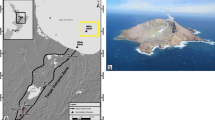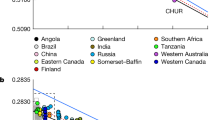Abstract
The outcome of the Apollo lunar exploration program 1969–1974 was a model of lunar petrogenesis which ignored the probability of selective volatilisation of gases and alkalis from fire-fountaining lunar basalts. It overlooked the fact that the average compositions of the erupted basalts were those of plagioclase-saturated and low-pressure cotectic liquids on eruption, clearly indicating that they were not primary magmas. The basalts may have undergone evolution by gabbro fractionation within the lunar crust, perhaps in large lava lakes now solidified as the lunar maria. The existing model involving a global magma ocean and plagioclase flotation to form the lunar crust arises solely from the incorrect assumption that the basalts are primary magmas. The plagioclase flotation hypothesis requires the presence of a significant positive europium anomaly in the lunar highland crust, and was founded upon its alleged presence. However, that positive anomaly is neither established by the original data set nor by the much broader current data set. Critical observations, and experiments which will advance the debate are suggested, and alternative interpretations outlined.
Similar content being viewed by others
References
Taylor, S. R., Lunar Science: A Post-Apollo View, New York: Pergamon, 1975, 372.
Heiken, G., Vaniman, D., French, B. M., Lunar Sourcebook: A User’s Guide to the Moon, Cambridge: Cambridge University Press, 1991, 736.
Papike, J. J., Ryder, G., Shearer, C. K., Lunar materials, in Planetary Materials, Reviews in Mineralogy 36 (ed. Papike, J. J.), Washington: Mineralogical Soc. America, 1998, 5.1–5.234.
O’Hara, M. J., Flood basalts, basalt floods or topless bushvelds? Lunar Petrogenesis Revisited, J. Petrol., 2000, 41: 1545–1651.
O’Hara, M. J., Feldspathic mare basalts at the Apollo 17 landing site, Taurus-Littrow, J. Petrol., 2001, 42: 1401–1427.
Carmichael, I. S. E., Turner, F. J., Verhoogen, J., Igneous Petrology, New York: McGraw-Hill, 1974, 739.
O’Hara, M. J., Herzberg, C., Interpretation of trace element and isotope features of basalts: relevance of field relations, major element data, phase equilibria and magma chamber modelling in basalt petrogenesis, Geochim. Cosmochim. Acta, 2002, 66: 2167–2191.
Taylor, S. R., Flood Basalts, Basalt floods or topless bushvelds? Lunar petrogenesis revisited: a critical comment, J. Petrol., 2001, 42: 1219–1220.
O’Hara, M. J., Flood basalts, basalt floods or topless bushvelds? Lunar petrogenesis revisited: a reply, J. Petrol., 2001, 42: 1221–1224.
Bugiolacchi, R., Spudis, P. D., Guest, J. E., Lava flows in Mare Nubium and Mare Cognitum: A geological history based on analysis of multispectral data, Lunar and Planetary Science XXXV (Abstract), 2004. (http: //www.lpi.usra.edu/meetings/lpsc2004/pdf/1507.pdf)
Anand, M., Taylor, L. A., Neal, C. et al., Petrology and geochemistry of LAP 02 205: A new low-Ti mare basalt meteorite, Lunar and Planetary Science XXXV (Abstract), 2004. (http: //www.lpi.usra. edu/meetings/lpsc2004/pdf/1626.pdf)
Jolliff, B. L., Zeigler, R. A., Korotev, R. L., Petrography of lunar meteorite LAP 02205, a new low-Ti basalt possibly launch paired with NWA 032, Lunar and Planetary Science XXXV (Abstract), 2004. (http://www.lpi.usra.edu/meetings/lpsc2004/pdf/1438.pdf)
Mikouchi, T., Chokai, J., Arai, T. et al., LAP02205 lunar meteorite: Lunar mare meteorite with similarities to the Apollo 12 ilmenite basalt. Lunar and Planetary Science XXXV (Abstract), 2004. (http://www.lpi.usra.edu/meetings/lpsc2004/pdf/1548.pdf)
Righter, K., Brandon, A. D., Norman, M. D., Mineralogy and petrology of unbrecciated lunar basaltic meteorite LAP 02205, Lunar and Planetary Science XXXV (Abstract), 2004. (http://www.lpi. usra.edu/meetings/lpsc2004/pdf/1667.pdf)
Korotev, R. L., Zeigler, R. A., Jolliff, B. L., Compositional constraints on the launch pairing of LAP 02205 and PCA 02007 with other lunar meteorites, Lunar and Planetary Science XXXV (Abstract), 2004. (http://www.lpi.usra.edu/meetings/lpsc2004/pdf/1416. pdf)
Shkuratov, Yu., Pinet, P., Omelchenko, V. et al., Derivation of elemental abundance maps at 15-km spatial resolution from the merging of Clementine optical and Lunar Prospector geochemical data, Lunar and Planetary Science XXXV (Abstract), 2004. (http: //www.lpi.usra.edu/meetings/lpsc2004/pdf/1162.pdf)
Elkis-Tanton, L. T., Hager, B. H., Grove, T. L., Magmatic effects of the lunar late heavy bombardment, Earth Planet. Sci. Lett., 2004, 222: 17–27.
Keifer, W. S., Gravity evidence for an extinct magma chamber beneath Syrtis Major, Mars: a look at the magmatic plumbing system, Earth Planet. Sci. Lett., 2004, 222: 349–361.
Author information
Authors and Affiliations
Corresponding author
About this article
Cite this article
O’Hara, M.J. New moon from an old hand. Chin.Sci.Bull. 49, 1788–1800 (2004). https://doi.org/10.1007/BF03183402
Received:
Accepted:
Issue Date:
DOI: https://doi.org/10.1007/BF03183402




